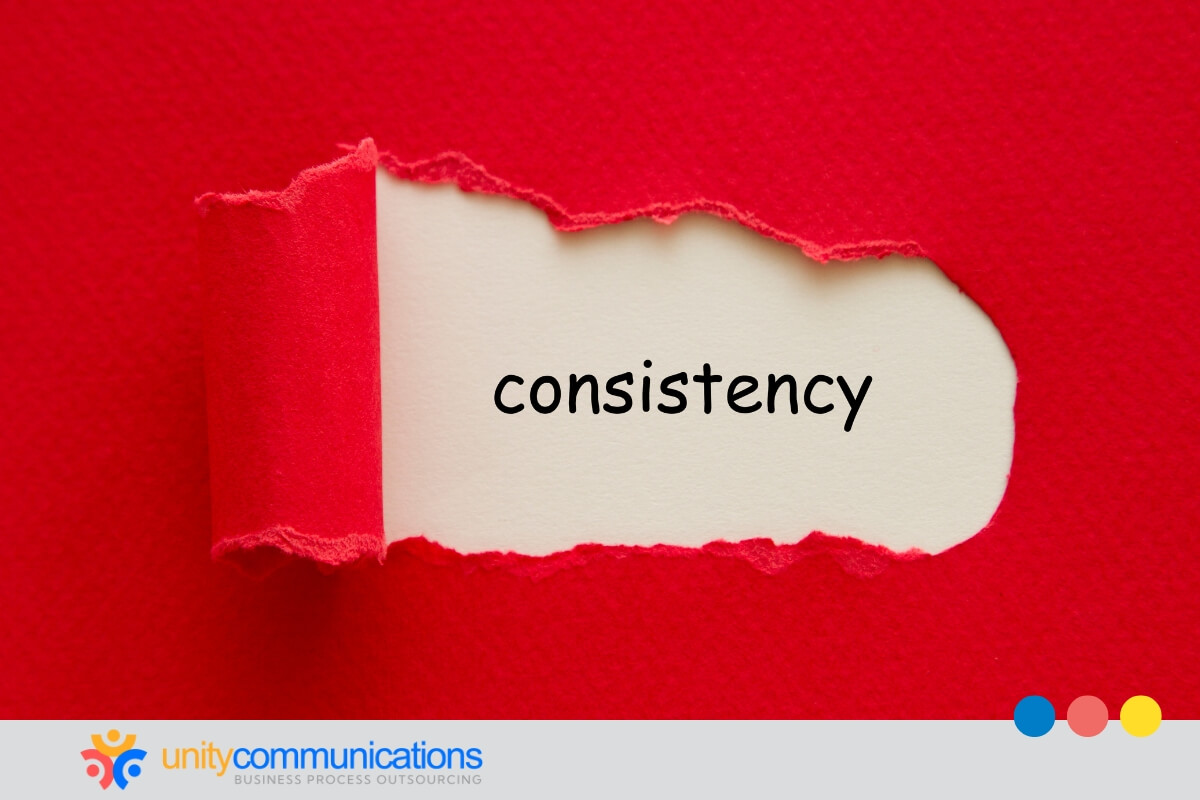Table of Contents
Compelling content builds brand awareness, engages customers, and drives conversions. However, consistently creating high-quality output can be challenging.
Businesses have two options: build and manage an in-house content team or leverage business process outsourcing (BPO) services. Each approach has advantages and drawbacks. The right choice depends on business goals, resources, and budget.
If you need help deciding between the two approaches, this article is for you. It breaks down the primary differences of outsourcing vs. in-house content creation, covering the benefits and challenges to inform your decision.
What is in-house content creation?

In-house content creation involves hiring a dedicated team to handle all content-related tasks within your organization. It typically includes writers, editors, search engine optimization (SEO) specialists, graphic designers, and videographers.
They are responsible for creating blog posts, social media content, video scripts, email campaigns, and more.
Pros of in-house content creation
Compared to outsourcing, how does in-house content creation benefit your business? Choosing to create content in-house comes with several advantages:
- Brand familiarity and consistency. An internal team works closely with your brand daily, ensuring content aligns perfectly with your voice, mission, and values. Messaging and tone remain consistent across all platforms to strengthen brand identity.
- Quick turnaround and real-time collaboration. You can quickly communicate feedback and make real-time changes with an in-house team. Teams can collaborate across departments, aligning content with business objectives and marketing strategies.
- Full control over content strategy. Businesses have complete oversight of content schedules, quality control, and workflow. Customization is more effortless, allowing for on-the-fly adjustments to campaigns and strategies.
Cons of in-house content creation
Although in-house content creation is generally advantageous, it can also introduce business performance issues. Here are some of the most common disadvantages of businesses:
- High costs. Hiring, training, and maintaining a full-time content team requires significant financial investment. Salaries, benefits, tools, and software subscriptions can add up quickly.
- Limited skill set and scalability. Your team might lack specialized skills, such as SEO expertise, video editing, or graphic design. Scaling up content production might require hiring additional employees, which can be costly and time-consuming.
- Burnout and creativity fatigue. Producing content regularly can be challenging, leading to creative blocks and lower productivity. Employees might struggle with fresh ideas, affecting content quality and engagement over time.
What is content creation outsourcing?

Outsourcing involves delegating a portion, if not all, of your content creation processes to an external team. You hire content marketing specialists who act as an extension of your internal staff—that’s what BPO is.
Reputable outsourcing providers have a broad talent pool of content writers, editors, SEO specialists, graphic designers, and videographers. They can create various types of content, including blog articles, website copy, social media posts, videos, and infographics.
Pros of outsourcing content creation
Content creation outsourcing is widespread across businesses of all sizes and industries. According to the Content Marketing Institute (CMI) research, 50% of polled organizations outsource content marketing. Seventy-five percent of respondents are from large companies, and 54% are successful in this endeavor.
What are the advantages of outsourcing compared to in-house operations for content creation? Let’s explore its benefits:
- Access to specialized expertise. Outsourcing providers bring experts in content strategy and planning, content marketing and distribution, and technical, medical, and financial writing. These professionals stay updated with industry trends to deliver high-performing outputs.
- Leverage of advanced tools and software. Reputable BPO providers carry cutting-edge technologies that help streamline content operations. These include SEO tools, data analysis software, cloud platforms, artificial intelligence (AI), and automation tools.
- Scalability and flexibility. BPO partnerships let you quickly scale content production based on demand—that’s how outsourcing works. It allows you to launch large-scale campaigns without the hassle of hiring additional staff. Additionally, automation tools and AI make it easier to meet surging demands.
- Faster turnaround and fresh perspectives. BPO teams specialize in managing large-scale content production efficiently, ensuring timely delivery while maintaining quality. They bring structured workflows, industry expertise, and strategic insights, enhancing content innovation and freshness.
- Cost-effectiveness. According to Deloitte, 83% of businesses that outsource report reducing costs. That’s because most outsourcing providers hire from areas with lower living expenses, resulting in lower wages than an in-house content creation team. Research suggests BPO can cut labor costs by up to 70%.
Cons of outsourcing content creation
As with operating in-house, outsourcing content creation has its potential risks and challenges. Here are some drawbacks you must carefully consider to ensure you make the best decision for your content strategy:
- Less brand familiarity. Outsourcing teams might not fully understand your brand voice, requiring extra effort in communication and guidelines. Consistency in messaging might be challenging, especially if working with multiple freelancers.
- Communication barriers. Depending on time zones and work arrangements, real-time collaboration might be complex. Some outsourcing providers might require multiple revisions to align content with your expectations.
- Risk of quality variations. Not all content from outsourcing teams meets the same quality standards, requiring thorough vetting and revisions. Some agencies or freelancers might prioritize speed over accuracy and creativity.
Determining the right approach for your business

When deciding between outsourcing and in-house content creation, consider the following factors:
- Budget. If you have the resources to hire and maintain a content team, in-house creation might be a good fit. However, outsourcing can be more cost-effective for businesses looking to reduce expenses.
- Content volume. If you need high volumes of diverse content, outsourcing provides flexibility without overwhelming an internal team.
- Brand identity and control. Companies prioritizing brand consistency prefer an in-house approach, whereas those open to fresh perspectives can benefit from outsourcing.
- Expertise needs. If you require specialized content (e.g., technical writing, video production), outsourcing offers access to professionals with the necessary skills.
- Scalability and growth. Startups and fast-growing businesses might find outsourcing a more efficient way to scale content production without the burden of hiring.
Key differences between outsourced and in-house content creation
To better help you with your decision-making, we’ve summarized the key pros and cons of outsourcing and operating content creation in-house. Here are some differences you should highly consider:
| Feature | In-house content creation | Outsourced content creation |
|---|---|---|
| Cost | Higher (salaries, software, training) | Lower (pay per project or contract) |
| Expertise | Limited to in-house team skills | Access to a diverse talent pool |
| Scalability | Harder to scale without hiring more staff | Easily adjustable based on demand |
| Turnaround time | Can be quick but depends on the workload | Often faster due to dedicated professionals |
| Creativity and fresh ideas | Might experience creative fatigue | Fresh perspectives from external content creators |
| Brand consistency | Strong alignment with brand voice | Requires extra effort to maintain consistency |
| Control and oversight | Full control over content strategy | Less direct control, requires trust |
The hybrid approach: Best of both worlds
Balancing between outsourcing and in-house content creation might be ideal for your business. It lets you enjoy the benefits of both practices while reducing the risks that come with them.
Here’s a quick example of how you can merge the two strategies:
- Maintain an in-house team to oversee brand messaging and handle high-priority content.
- Outsource specialized tasks such as SEO blogging, graphic design, or video production.
- Adjust BPO service levels during peak periods to manage workload efficiently.
The bottom line
Comparing outsourcing vs. in-house content creation depends on your business goals, budget, and content needs.
While in-house teams provide brand consistency and control, outsourcing offers flexibility, cost savings, and specialized expertise. However, it’s not unusual to utilize both models to leverage their strengths.
Let’s connect if you want to learn more about which strategy is best for your content marketing goals!




